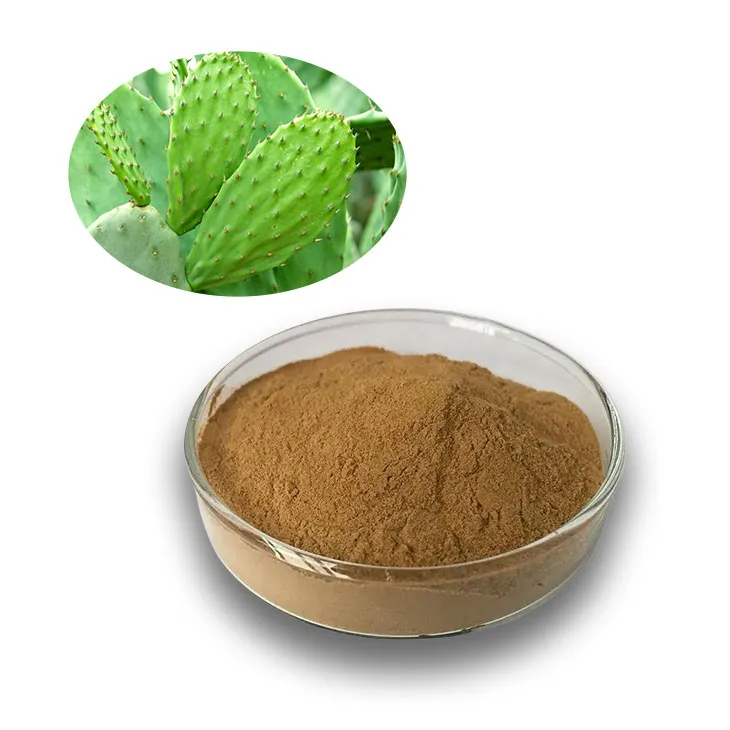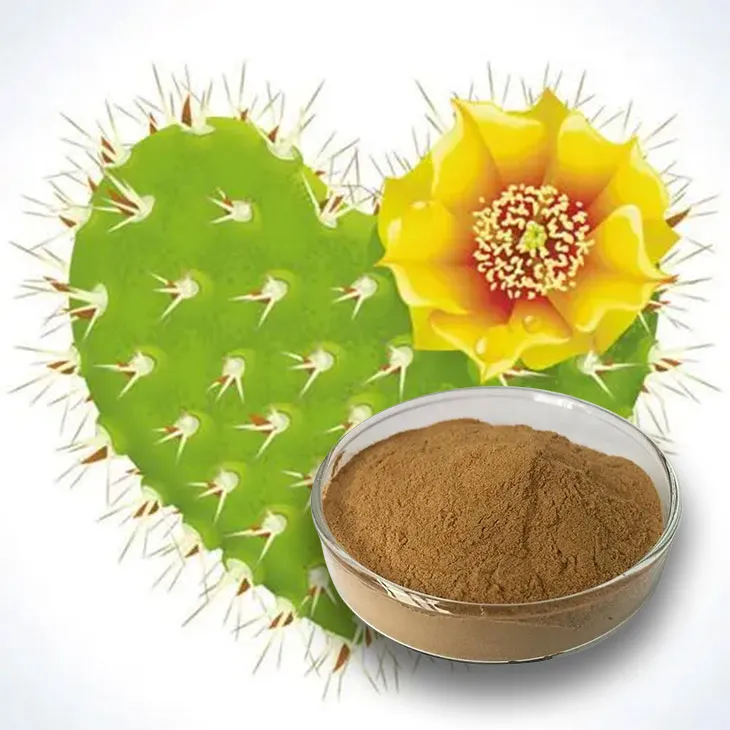- 0086-571-85302990
- sales@greenskybio.com
The flavor of mature cactus and natural cactus extract.
2024-11-11

1. Introduction
Cacti are remarkable plants that have adapted to arid environments. Their unique characteristics extend beyond their physical appearance, as both the flavor of mature cacti and natural Cactus Extracts offer a world of possibilities. This article aims to comprehensively explore these aspects, shedding light on their culinary, health, and industrial significance.

2. The Flavor of Mature Cactus
2.1 Taste Profile
The flavor of a mature cactus can be quite distinctive. It often has a subtle earthiness combined with a hint of acidity. Some species of mature cacti may also have a slightly sweet undertone, which is a pleasant surprise considering their spiky and tough exterior. For example, the prickly pear cactus, when fully mature, has a flavor that can be described as a blend of these elements, making it an interesting addition to various dishes.
2.2 Texture and Mouthfeel
The texture of mature cactus is also a factor that contributes to its overall flavor experience. It can range from being relatively crisp in some parts to having a more tender and gelatinous consistency in others. This variety in texture adds depth to the eating experience. When cooked, the texture may change further, becoming more soft and pliable, which can enhance the way it interacts with other ingredients in a dish.
2.3 Factors Affecting the Flavor
- Soil Conditions: The type of soil in which the cactus grows can have a significant impact on its flavor. Cacti grown in well - drained, mineral - rich soils may develop more complex and nuanced flavors compared to those in poorer soils.
- Climate: The climate of the region, including factors such as temperature, sunlight exposure, and rainfall patterns, also plays a role. Cacti in hotter and drier climates may have a more concentrated flavor due to the stress of the environment.
- Maturity Level: As the cactus matures, its flavor evolves. Immature cacti may have a more bitter or underdeveloped flavor, while fully mature ones offer the full spectrum of taste characteristics.

3. Natural Cactus Extracts
3.1 Extraction Methods
- Solvent Extraction: This is one of the most common methods. Organic solvents such as ethanol or methanol are used to extract the active compounds from the cactus. The cactus material is typically soaked in the solvent, and then the solvent is evaporated to obtain the extract. However, it is important to ensure that all traces of the solvent are removed to avoid any potential toxicity.
- Pressurized Liquid Extraction: This method uses high - pressure liquid to extract the compounds. It is often more efficient than solvent extraction as it can extract a wider range of compounds in a shorter time. The high - pressure environment helps to break down the cell walls of the cactus more effectively.
- Supercritical Fluid Extraction: Supercritical carbon dioxide is used as the extraction medium. This method has the advantage of being more environmentally friendly compared to traditional solvent extraction methods, as carbon dioxide is non - toxic and easily removed. It can also produce high - quality extracts with a high concentration of active compounds.
3.2 Composition of Natural Cactus Extracts
Natural cactus extracts are rich in a variety of compounds. They typically contain polyphenols, which are known for their antioxidant properties. These polyphenols can include flavonoids and phenolic acids. Additionally, cactus extracts may contain betalains, which are pigments responsible for the vivid colors in some cacti. They also contain minerals such as calcium, magnesium, and potassium, as well as vitamins like vitamin C and vitamin E. These components contribute to the potential health benefits and unique properties of the extracts.

4. Culinary Uses
4.1 In Traditional Cuisines
In some traditional cuisines, mature cacti and their extracts have been used for centuries. For example, in Mexican cuisine, the prickly pear cactus is a common ingredient. It can be used in both raw and cooked forms. The pads of the cactus, known as nopales, are often cooked and added to salads, stews, or tacos. The fruits of the prickly pear cactus are also used to make jams, jellies, and beverages. The unique flavor of the cactus adds a touch of novelty and local flavor to these traditional dishes.
4.2 In Modern Gastronomy
Modern chefs have also discovered the potential of mature cactus and cactus extracts in creating innovative dishes. They are used to add an unexpected flavor and texture to haute cuisine. Cactus extracts can be used in the form of gels, powders, or syrups to enhance the visual appeal and taste of a dish. For instance, a chef might use cactus extract gel to create a unique layer in a dessert or use powdered cactus extract as a seasoning for a savory dish.
5. Health Benefits
5.1 Antioxidant Properties
The polyphenols present in natural cactus extracts, as mentioned earlier, are powerful antioxidants. Antioxidants help to neutralize free radicals in the body, which are unstable molecules that can cause damage to cells. By reducing oxidative stress, cactus extracts may contribute to a lower risk of chronic diseases such as heart disease, cancer, and neurodegenerative disorders.
5.2 Anti - inflammatory Effects
Studies have suggested that cactus extracts may have anti - inflammatory properties. Inflammation is a natural response of the body, but chronic inflammation can lead to various health problems. The compounds in cactus extracts may help to reduce inflammation by modulating the body's immune response. This could potentially be beneficial for conditions such as arthritis and inflammatory bowel disease.
5.3 Digestive Health
Some components of cactus extracts may also promote digestive health. They can help to regulate the digestive system, improve bowel movements, and may even have a prebiotic effect, promoting the growth of beneficial gut bacteria. This can contribute to overall gut health and may have implications for conditions such as constipation and indigestion.
6. Industrial Applications
6.1 Cosmetics
The antioxidant and anti - inflammatory properties of cactus extracts make them suitable for use in cosmetics. They can be added to skin care products such as creams, lotions, and serums. Cactus extracts may help to protect the skin from environmental damage, reduce signs of aging such as wrinkles and fine lines, and soothe irritated skin. Additionally, the betalains in cactus extracts can be used as natural colorants in cosmetics, providing a more natural alternative to synthetic dyes.
6.2 Pharmaceuticals
There is ongoing research into the potential pharmaceutical applications of cactus extracts. Their anti - inflammatory and antioxidant properties may be harnessed to develop new drugs for treating various diseases. For example, they could be used in the development of drugs for treating chronic inflammatory conditions or as adjuvants to enhance the effectiveness of existing medications. However, more research is needed to fully understand their pharmacological potential and to ensure their safety and efficacy.
6.3 Food and Beverage Industry
In the food and beverage industry, cactus extracts can be used as natural flavor enhancers and preservatives. Their unique flavor can add depth to a variety of products, from juices and smoothies to processed foods. As preservatives, they can help to extend the shelf life of products by inhibiting the growth of spoilage - causing microorganisms. Additionally, the natural colorants in cactus extracts can be used to color food products in a more natural way, appealing to consumers who prefer natural ingredients.
7. Conclusion
The flavor of mature cacti and natural cactus extracts are truly fascinating aspects of these remarkable plants. Their unique taste, texture, and composition offer a wide range of possibilities in the culinary, health, and industrial fields. As research continues to uncover more about their properties and potential applications, we can expect to see even more innovative uses of cacti in the future. Whether it's in the kitchen, the pharmacy, or the cosmetics counter, cacti have the potential to make a significant impact.
FAQ:
What are the main components contributing to the mature cactus flavor?
The mature cactus flavor is a complex combination of various components. It may be influenced by the presence of certain sugars, organic acids, and unique secondary metabolites. Some cacti contain fructose and glucose, which can contribute to a slightly sweet taste. Organic acids like malic acid can add a tangy note. Additionally, specific phenolic compounds and alkaloids in cacti may also play a role in creating the distinct flavor profile.
How is the natural cactus extract obtained?
Natural cactus extract can be obtained through several methods. One common approach is solvent extraction. In this method, a suitable solvent such as ethanol or water is used to dissolve the active compounds from the cactus tissue. Another method is cold - pressing, especially for cacti that have a relatively high water content. The cactus material is pressed to release the juice, which contains the extract. Supercritical fluid extraction using carbon dioxide is also an option in some cases, as it can selectively extract certain compounds while leaving behind unwanted substances.
What are the culinary uses of the mature cactus flavor?
The mature cactus flavor can be used in various culinary applications. In Mexican cuisine, for example, the pads of certain cacti, known as nopales, are cooked and used in dishes like salads, tacos, and stews. The unique flavor adds a fresh and slightly earthy - tangy taste. The flavor can also be incorporated into salsas, where it combines well with tomatoes, onions, and peppers. Some cactus fruits are used to make jams, jellies, and desserts, bringing a sweet - tart flavor.
What are the health benefits associated with natural cactus extract?
Natural cactus extract has several potential health benefits. It may have antioxidant properties due to the presence of phenolic compounds. These antioxidants can help protect the body's cells from oxidative stress. Some cactus extracts are believed to have anti - inflammatory effects, which could be beneficial for conditions related to inflammation such as arthritis. Additionally, cactus extracts may have a role in regulating blood sugar levels, as some studies suggest that they can affect glucose metabolism in the body.
How is natural cactus extract used in the cosmetic industry?
In the cosmetic industry, natural cactus extract is used for multiple purposes. It can be used in moisturizers and creams due to its water - retaining properties. The extract may help keep the skin hydrated. It is also sometimes used in anti - aging products as its antioxidant properties can potentially reduce the signs of aging, such as wrinkles and fine lines. Additionally, cactus extract may have soothing properties, making it suitable for use in products for sensitive skin.
Related literature
- The Chemical Composition and Flavor Profile of Mature Cacti"
- "Natural Cactus Extracts: Properties and Potential Applications"
- "Culinary and Medicinal Uses of Cacti: A Comprehensive Review"
- ▶ Hesperidin
- ▶ citrus bioflavonoids
- ▶ plant extract
- ▶ lycopene
- ▶ Diosmin
- ▶ Grape seed extract
- ▶ Sea buckthorn Juice Powder
- ▶ Beetroot powder
- ▶ Hops Extract
- ▶ Artichoke Extract
- ▶ Reishi mushroom extract
- ▶ Astaxanthin
- ▶ Green Tea Extract
- ▶ Curcumin Extract
- ▶ Horse Chestnut Extract
- ▶ Other Problems
- ▶ Boswellia Serrata Extract
- ▶ Resveratrol Extract
- ▶ Marigold Extract
- ▶ Grape Leaf Extract
- ▶ blog3
- ▶ blog4
- ▶ blog5
-
Organic Tongkat Ali extract powder factory.
2024-11-11
-
How to make powder with ashwagandha extract.
2024-11-11
-
Rosehip extract manufacturers from China.
2024-11-11
-
The best cat's claw extract in nature.
2024-11-11
-
Chinese Dandelion Leaf Extract Suppliers.
2024-11-11
-
Nettle Root Extract
2024-11-11
-
Artichoke Leaf Extract
2024-11-11
-
Natural grape seed extract
2024-11-11
-
Kidney Bean Extract
2024-11-11
-
Troxerutin
2024-11-11
-
Sea buckthorn oil
2024-11-11
-
Fig Extract
2024-11-11
-
Sea buckthorn Juice Powder
2024-11-11
-
Tinospora cordifolia extract
2024-11-11
-
Curcumin
2024-11-11





















